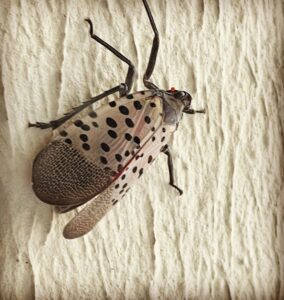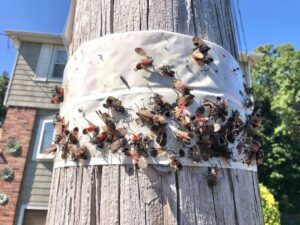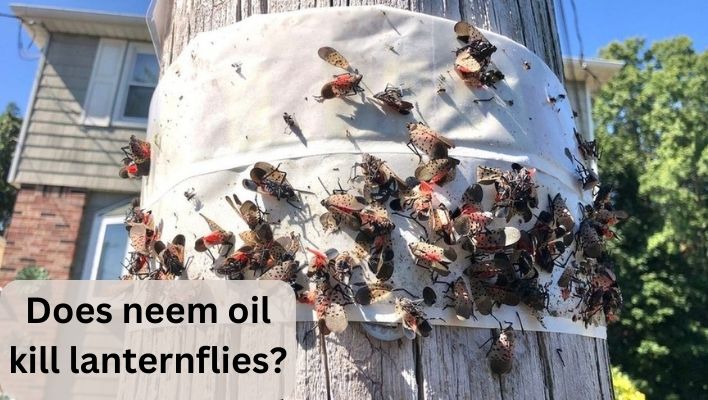Have you heard of the lanternfly? These pesky insects have become a major problem for farmers and gardeners in certain parts of the United States.
These pests are one of the most destructive insect pests that have been causing havoc in several states in the US. Native to Asia, the spotted lanternfly was first discovered in Pennsylvania in 2014 and has since spread to other states, including Delaware and New Jersey.
With their voracious appetite for plants and trees, they can cause significant damage to crops, gardens, and landscapes. They feed on the sap of trees and plants, causing significant damage and even death to crops and trees.
Not only do they pose a threat to agriculture, but they also disrupt local ecosystems by harming native plant and animal species.
In recent years, neem oil has become a popular solution to combat these pests. But does neem oil kill lanternflies?
Many people are turning to neem oil as a natural, eco-friendly solution to combat pests. Neem oil is derived from the seeds of the neem tree and has been used for centuries in traditional medicine and as a natural pesticide. But can neem oil kill lanternflies?
In this article, we’ll explore the effectiveness of neem oil as a natural insecticide and whether it’s a viable option for controlling the spread of spotted lanternflies.
We will delve into the science behind neem oil and its insecticidal properties and discuss how it can be used to combat these pests. So, if you’re looking for a natural and eco-friendly solution to get rid of lanternflies, keep reading to find out if neem oil is the answer you’ve been looking for.
Lanternflies and their Threats
The spotted lanternfly is a striking insect with a distinctive appearance. They have black bodies with white spots and red underwings. They are about one inch long and half an inch wide. These insects were first detected in the United States in 2014 in Berks County, Pennsylvania. Since then, they have spread to other states and have become a significant threat to agriculture and the environment.
Lanternflies are notorious for their voracious appetite. They feed on the sap of trees and plants, which can lead to significant damage and even death of the host plant. The insects pierce the bark of the trees and suck out the sap, causing the leaves to wilt and turn brown. They also excrete a sticky substance called honeydew, which can attract other pests like ants and wasps.

The damage caused by lanternflies is not just limited to crops and plants. They also pose a threat to the environment by disrupting the balance of ecosystems. As they feed on the sap of trees, they weaken the trees and make them more susceptible to disease and other pests. This can have a ripple effect on the rest of the ecosystem by reducing the availability of food and shelter for other species.
Controlling the spread of the spotted lanternfly is essential to protect both agriculture and the environment. They can cause significant economic damage by reducing crop yields and killing trees if left unchecked. They also pose a significant threat to native species and can disrupt the delicate balance of ecosystems. That’s why it is crucial to find effective and sustainable solutions to control their populations.
What is neem oil?
Neem oil is a natural insecticide used for centuries in traditional medicine and agriculture. It’s derived from the seeds of the neem tree, which is native to India and other parts of Southeast Asia. In ancient Indian texts, neem was referred to as the “village pharmacy” due to its numerous medicinal properties.
The composition of neem oil is complex, with over 140 active compounds identified. The primary insecticidal compound is called azadirachtin, which is known to disrupt the feeding and reproductive habits of insects. Other compounds found in neem oil include nimbin, nimbidin, and salannin, all of which contribute to its insecticidal properties.

One of the main advantages of using neem oil as a natural insecticide is that it’s non-toxic to humans and animals. Unlike chemical pesticides, neem oil breaks down quickly in the environment and doesn’t leave harmful residues.
It’s also effective against many insect pests, including aphids, mites, and whiteflies. Another advantage is that neem oil can be used as a preventive measure to repel insects before they become a problem.
Additionally, neem oil has been shown to have other beneficial properties, such as antifungal and antibacterial properties. This makes it useful for preventing and treating plant diseases. Neem oil is a safe and effective alternative to chemical pesticides that can help control insect pests without harming the environment or beneficial insects.
Does neem oil kill lanternflies?
Now that we know what neem oil is and its insecticidal properties, the question remains: does neem oil kill lanternflies? The short answer is yes; neem oil is effective against lanternflies.
Neem oil disrupts insects’ feeding and reproductive habits, including lanternflies. When the insects ingest or come into contact with neem oil, it can interfere with their hormonal balance and lead to reduced feeding, growth, and reproduction. The azadirachtin in neem oil is particularly effective against insects by affecting their molting and metamorphosis.
Several studies have shown that neem oil can be an effective tool for controlling lanternflies. In a study conducted by researchers at Penn State University, neem oil significantly reduced lanternfly populations on grapevines. Another study published in the Journal of Economic Entomology found that neem oil effectively reduced the number of lanternfly eggs laid on plants.

While neem oil is an effective natural insecticide, it has some pros and cons for lanternfly control. One advantage is that neem oil is eco-friendly and won’t harm beneficial insects like bees and ladybugs. It’s also safe to use around humans and pets.
Neem oil can be used in a variety of ways to control lanternflies. It can be applied as a spray directly on the insects or plants and trees they are infesting. It can also be used as a soil drench or injected into the tree trunks to reach the root system and provide longer-lasting protection.
On the downside, neem oil needs to be applied regularly and can be washed away by rain, which may require additional applications. It also needs to be applied directly to the insects or their eggs, which can be time-consuming and labor-intensive.
Overall, neem oil is a promising natural solution for controlling lanternflies and other pests populations. While it may not be the most convenient option, it’s a safe and effective alternative to chemical pesticides that can harm the environment and other species.
However, it is important to note that neem oil should be used in moderation and according to the manufacturer’s instructions. Overuse or misuse can adversely affect beneficial insects and plants, so it is important to use it responsibly.
How to use neem oil to kill lanternflies?
If you’re interested in using neem oil to control lanternflies, here are some instructions on how to prepare and apply it:
- Purchase pure neem oil from a reputable source.
- Dilute the neem oil: Neem oil is a concentrated substance and needs to be diluted before use. Mix one tablespoon of neem oil with one gallon of water.
- Fill a spray bottle: Once the neem oil is diluted, pour it into a spray bottle.
- Apply the neem oil: Spray the neem oil directly onto the lanternflies or their eggs, thoroughly covering the affected areas. Neem oil can also be used preventatively by spraying it on plants before an infestation occurs.
- Repeat as needed: Neem oil needs to be reapplied regularly, especially after rain or heavy watering. Aim to apply the neem oil every 7-14 days for best results.
When using neem oil, it’s important to take some precautions and follow safety tips:
- Wear protective clothing: Wear gloves, long sleeves, and pants when handling neem oil to avoid skin irritation.
- Don’t apply in direct sunlight: Neem oil can cause plant leaves to burn if applied in direct sunlight. Apply it early morning or evening when the sun is less intense.
- Avoid spraying on windy days: Neem oil can be blown off the plants by wind, reducing its effectiveness.
- Store neem oil properly: Keep neem oil in a cool, dry place away from direct sunlight.
How to get rid of lanternflies on trees
In addition to using neem oil, there are some best practices for preventing and managing lanternfly infestations. Or when dealing with lanternflies on your trees, there are several steps you can take to get rid of them:

- Remove egg masses – Lanternflies lay their eggs in clusters on tree trunks, branches, and other surfaces. Look for egg masses and scrape them off with a credit card or similar tool. Dispose of the egg masses in a sealed bag or container.
- Use sticky bands – Sticky bands wrapped around tree trunks can trap nymphs as they crawl up and down the tree. Replace the bands as needed, and dispose of any trapped insects in a sealed bag or container.
- Prune-affected branches – If you notice lanternflies on specific branches of your tree, pruning those branches may be an effective way to get rid of them. Dispose of the pruned branches in a sealed bag or container.
- Homemade sprays – As discussed earlier, homemade sprays can be a natural and effective way to kill lanternflies. These can be applied directly to the insects or sprayed on the tree to repel them.
- Biological control – Introducing natural predators or parasites can help reduce the population of lanternflies. However, this method can take time to be effective and may only be suitable for some situations.
- Use insecticides – Synthetic insecticides can effectively kill lanternflies but may also harm beneficial insects and pollinators. It’s important to read and follow the label instructions carefully and use insecticides safely and responsibly.
- Use natural remedies – As we discussed earlier, homemade sprays made from natural ingredients like soap, garlic, or neem oil can effectively kill lanternflies without harming beneficial insects or plants.
Overall, a combination of these methods may be necessary to get rid of lanternflies on trees effectively. It’s important to monitor the population and the effectiveness of the treatments over time and to be patient and persistent in your efforts to control these invasive pests. Protecting your trees and keeping your environment healthy and thriving is possible with the right approach.
Other ways kill lanternflies instantly.
There are several options available to kill lanternflies instantly, but it’s important to use them safely and responsibly to avoid harming beneficial insects and plants. Here are some options to consider:
- Insecticides – Synthetic insecticides like carbaryl, imidacloprid, and bifenthrin can kill lanternflies quickly, but they are also harmful to beneficial insects and can leave harmful residues in the environment.
- Soap and water – A dish soap and water solution can be sprayed directly on lanternflies to suffocate and kill them. This is a natural and non-toxic solution, but it may be less effective on larger populations.
- Sticky traps – Sticky traps coated with a sticky substance like Tanglefoot can be hung in trees to trap and kill lanternflies. This method is non-toxic and safe for beneficial insects but may be less effective in high-population areas.
- Vacuuming – Vacuuming up lanternflies can effectively kill them instantly, but it is labor-intensive and may not be practical for larger populations.
Overall, there are several options available to kill lanternflies instantly, but it’s important to consider the potential impact on beneficial insects and the environment. Using natural and non-toxic solutions like neem oil, soap, and water is often the safest and most effective approach.

Homemade spray to kill lanternflies
Homemade sprays are a great way to kill lanternflies without using harmful chemicals. Here are some different types of homemade sprays that you can make at home:
- Garlic spray – Garlic has natural insecticidal properties that can kill lanternflies. To make garlic spray, blend a few cloves with water and strain the mixture. Then, add a few drops of dish soap and spray the mixture on the lanternflies.
- Vinegar spray: This natural and acidic solution can kill lanternflies. Mix equal parts of white vinegar and water to make vinegar spray, and add a few drops of dish soap. Spray the solution directly on the lanternflies.
- Essential oil spray – Essential oils like peppermint, lavender, and eucalyptus have insecticidal properties that can kill lanternflies. To make an essential oil spray, mix a few drops of the oil with water and add a few drops of dish soap. Spray the solution directly on the lanternflies.
- Chili pepper spray – Chili pepper spray can be an effective way to kill lanternflies. To make chili pepper spray, blend chili peppers with water and strain the mixture. Then, add a few drops of dish soap and spray the mixture on the lanternflies.
- Soap and water spray – A solution of dish soap and water can also be an effective way to kill lanternflies. Mix a few drops of dish soap with water and spray the solution directly on the lanternflies.
When using homemade sprays, it’s important to test them on a small area of your plant first to make sure they don’t cause any damage. It’s also important to use caution when handling and spraying these solutions and to follow the instructions carefully.
It’s worth noting that homemade sprays may need to be applied more frequently than synthetic insecticides to achieve the desired results. Also, it’s important to follow the instructions carefully and avoid using too much of any one ingredient, as this can harm plants and other beneficial insects.
Another important consideration is timing. Lanternflies are most active in the summer, so applying treatments during this time is important to achieve the best results. Regular monitoring of the population and the effectiveness of the treatments is also key to keeping the infestation under control.
Best insecticide for spotted lanternfly
When selecting the best insecticide for spotted lanternflies, several options exist. Here are some of the most effective insecticides for controlling these invasive pests:
- Imidacloprid: This systemic insecticide is often used to control many pests, including spotted lanternflies. It is applied to the soil around the tree’s base, and the plant absorbs it through the roots. This insecticide can remain effective for several months, making it a popular choice for homeowners and professionals.
- Dinotefuran: This systemic insecticide can be used to control both adult and nymph lanternflies. It is applied directly to the tree’s trunk or sprayed on the foliage. Dinotefuran can provide quick results and is often used in combination with other treatments.
- Carbaryl: This contact insecticide can be applied directly to spotted lanternflies to kill them on contact. It is also effective in controlling other pests, including aphids and mites.
- Pyrethroids: This group of insecticides is often used to control a wide range of pests, including spotted lanternflies. They work by attacking the nervous system of the insects and can provide quick results.
It’s important to note that all insecticides should be used carefully and according to the instructions to avoid harming beneficial insects and the environment. It’s also important to consider the safety of humans and pets when using insecticides and to choose a safe and effective product for your specific situation.
Consulting with a professional pest control service can help select the best insecticide for your specific situation and ensure that it is used safely and effectively.
Conclusion
Lanternflies pose a serious threat to plants and crops, and controlling their populations is important to prevent further damage. Neem oil, a natural insecticide, has shown the potential to kill lanternflies thanks to its ability to disrupt their feeding and breeding cycles. However, while studies have shown promising results, more research is needed to fully understand the effectiveness of neem oil as a lanternfly control method.
If you’re dealing with a lanternfly infestation, using neem oil may be worth a try. Dilute the oil, fill a spray bottle, and apply it directly to the affected areas. Repeat regularly for best results. Remember to take precautions when handling neem oil and consider other best practices for preventing and managing lanternfly infestations.
In conclusion, while neem oil may not be a cure-all solution for lanternfly control, it’s an environmentally friendly option worth considering. By continuing to explore natural insecticides like neem oil, we can develop more sustainable methods for controlling pests and protecting our plants and crops.
